QuickLinks:
2700, 2701, 2702, 2703, 2704, 2705, 2706, 2707, 2708, 2709, 2710, 2711, 2712, 2713, 2714, 2715, 2716,
2717, 2718, 2719, 2720, 2721, 2722, 2723, 2724, 2725, 2726, 2727, 2728, 2729, 2730, 2731, 2732, 2733,
2734, 2735, 2736, 2737, 2738, 2739, 2740, 2741, 2742, 2743, 2744, 2745, 2746, 2747, 2748, 2749
Page last updated Dec 24, 2018
Checked Dreyer entries, Steinicke & Corwin databases
Updated formatting to current standard, added basic images, tags, captions
NEXT: Check other historical databases
FINAL: Verify identifications, add physical information, look for better images
NGC 2700
Recorded (1877) by Wilhelm Tempel
A magnitude 15.2 star in Hydra (RA 08 55 50.6, Dec -03 07 00)
Historical Identification: Per Dreyer, NGC 2700 (= GC 5437, Tempel, 1860 RA 08 48 45, NPD 94 34) is "extremely faint, very small, 1 arcmin north of 1727", GC 1727 being NGC 2699, which see for images. Dreyer gave the NPD for NGC 2699 as 92 35.0, so if NGC 2700 was an arcmin to the north, its NPD should have been 92 34, and the published value was off by 2 degrees, presumably due to a transcription or printing error. In any event, there is nothing to the north of NGC 2699 save for a few stars. As a result, the star just to the northeast of that galaxy is presumed to be NGC 2700, and its position is the one listed above.
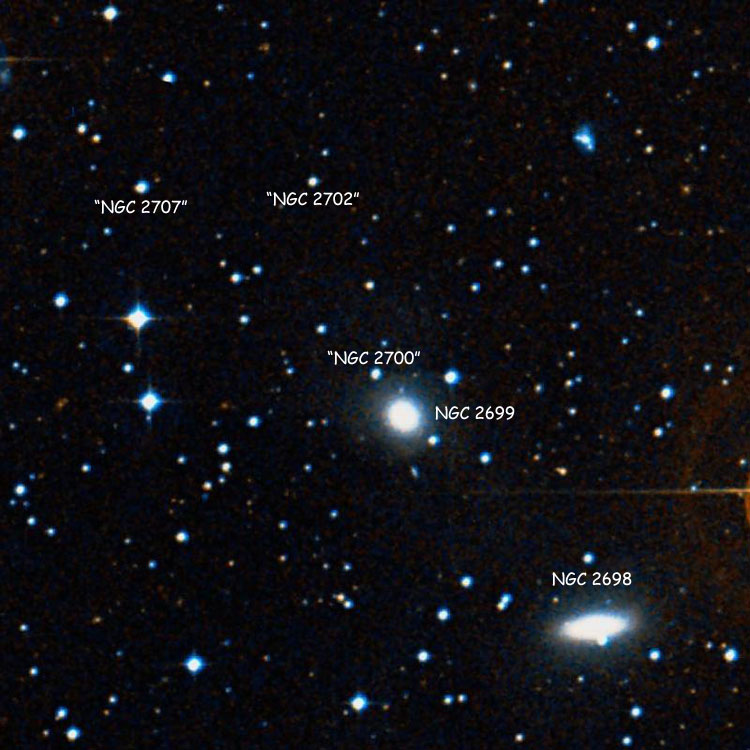
Above, a 12 arcmin wide DSS image centered on the star listed as NGC 2700
Also shown are NGC 2698, 2699, 2702 and 2707
NGC 2701 (= PGC 25237)
Discovered (Mar 18, 1790) by William Herschel
Also observed (Feb 10, 1831) by John Herschel
A magnitude 12.3 spiral galaxy (type SB(rs)bc?) in Ursa Major (RA 08 59 05.8, Dec +53 46 18)
Historical Identification: Per Dreyer, NGC 2701 (= GC 1728 = JH 537 = WH IV 66, 1860 RA 08 48 46, NPD 35 41.4) is "pretty bright, fan-shaped, 11th magnitude star attached".
Physical Information: Apparent size 2.2 by 1.6 arcmin.

Above, a 12 arcmin wide SDSS image centered on NGC 2701
Below, a 2.4 arcmin wide SDSS image of the galaxy

NGC 2702
Recorded (1876) by Wilhelm Tempel
A magnitude 15.2 star in Hydra (RA 08 55 54.6, Dec -03 03 55)
Historical Identification: Per Dreyer, NGC 2702 (= GC 5436, Tempel, 1860 RA 08 48 49, NPD 92 31.2) is "very faint, very small, 4 arcmin northeast of 1727", GC 1727 being NGC 2699, which see for an image. The published coordinates are 5sE and 3.8'N of those for NGC 2699, but as in the case of NGC 2700 there is nothing in the area save for a star located 2s due east of the relative position; so that is presumed to be Tempel's object, and its coordinates are the ones listed above. (Note: In the preceding 'calculation' I have used the relative positions stated in the NGC instead of precessing the 1860 coordinates, for when available, relative positions are a more reliable method of determining the positions of close objects.)
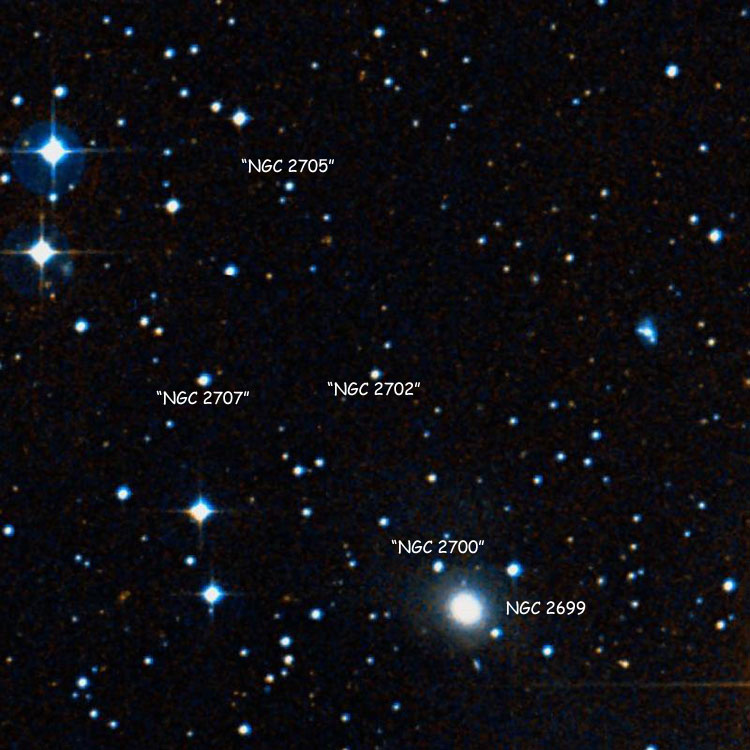
Above, a 12 arcmin wide DSS image centered on the star listed as NGC 2702
Also shown are 2699, 2700, 2705 and 2707
NGC 2703
Recorded (1876) by Wilhelm Tempel
A pair of magnitude 14.2 stars in Hydra (RA 08 55 47.1, Dec -03 18 26)
Historical Identification: Per Dreyer, NGC 2703 (= GC 5438, Tempel, 1860 RA 08 48 50, NPD 92 45) is "extremely faint, a little extended, doubtful".
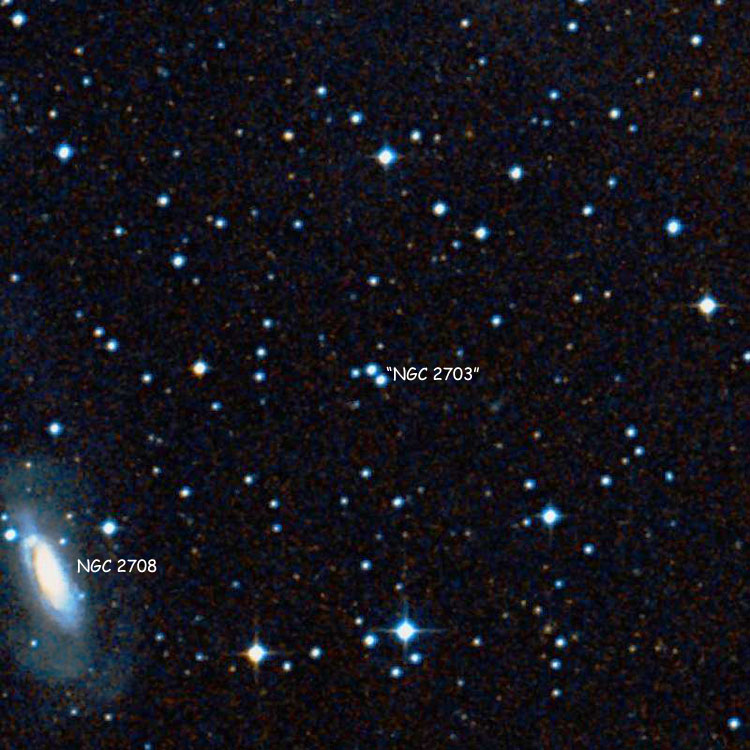
Above, a 12 arcmin wide DSS image centered on the double star listed as NGC 2703
Also shown is the galaxy listed as NGC 2708
NGC 2704 (= IC 2424 = PGC 25134)
Discovered (Mar 18, 1787) by William Herschel (and later listed as NGC 2704)
Discovered (Mar 18, 1892) by Guillaume Bigourdan (and later listed as IC 2424)
A magnitude 13.5 spiral galaxy (type SB(rs)ab?) in Lynx (RA 08 56 47.7, Dec +39 22 56)
Historical Identification: Per Dreyer, NGC 2704 (= GC 1729 = WH III 625, 1860 RA 08 48 54, NPD 50 07.4) is "very faint, very small".
Physical Information: Apparent size 1.0 by 1.0 arcmin.
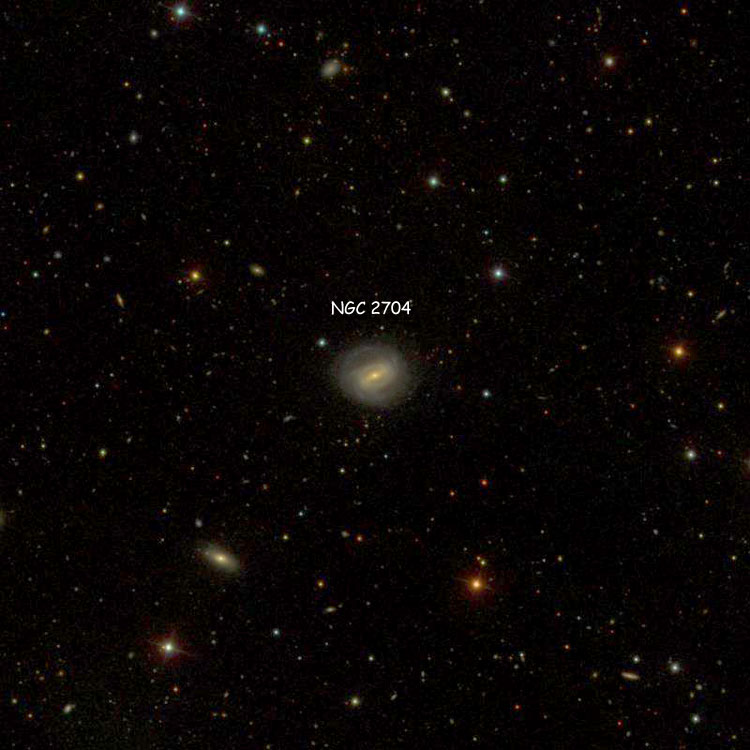
Above, a 12 arcmin wide SDSS image centered on NGC 2704
Below, a 1.5 arcmin wide SDSS image of the galaxy

NGC 2705
Recorded (1876) by Wilhelm Tempel
A magnitude 15.8 star in Hydra (RA 08 56 00.2, Dec -03 00 54)
Historical Identification: Per Dreyer, NGC 2705 (= GC 5439, Tempel, 1860 RA 08 48 55, NPD 92 28.2) is "very faint, very small, 3 stars of 14th magnitude to the east and northeast".
Physical Information:
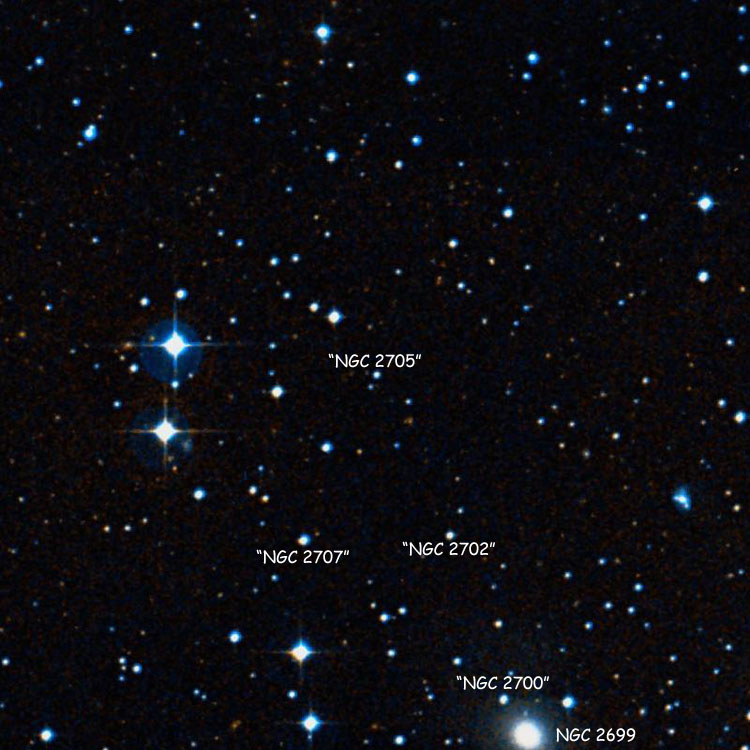
Above, a 12 arcmin wide DSS image centered on the star listed as NGC 2705
Also shown are 2699, 2700, 2702 and 2707
NGC 2706 (= PGC 25102)
Recorded (Feb 27, 1886) by Lewis Swift
A magnitude 13.0 spiral galaxy (type Sbc) in Hydra (RA 08 56 12.3, Dec -02 33 49)
Historical Identification: Per Dreyer, NGC 2706 (Swift list III (#42), 1860 RA 08 49 04, NPD 92 02.5) is "very faint, pretty small, much extended, star near to east".
Physical Information: Apparent size 1.8 by 0.6 arcmin.

Above, a 12 arcmin wide SDSS image centered on NGC 2706
Below, a 2.4 arcmin wide SDSS image of the galaxy
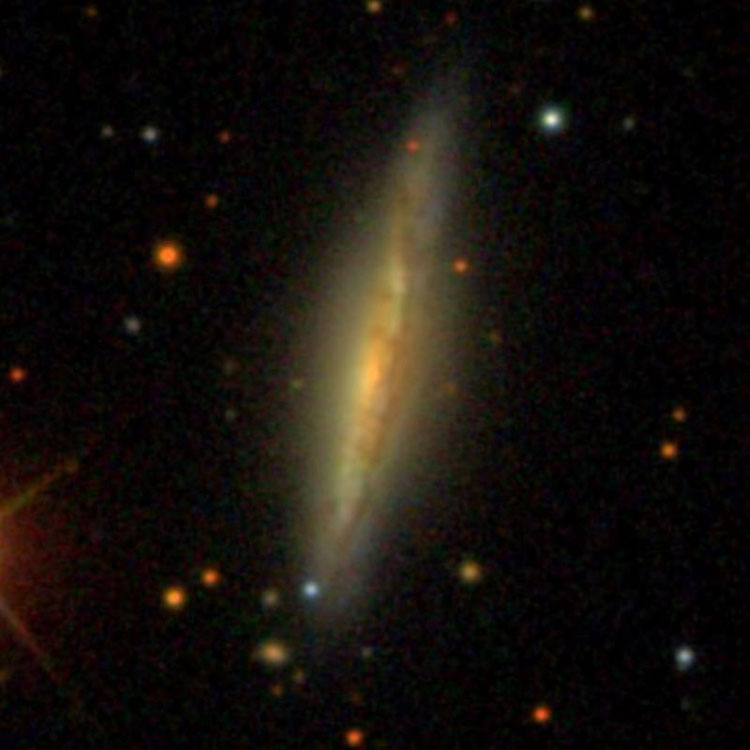
NGC 2707
Recorded (1876) by Wilhelm Tempel
A magnitude 14.1 star in Hydra (RA 08 56 05.6, Dec -03 04 00)
Historical Identification: Per Dreyer, NGC 2707 (= GC 5440, Tempel, 1860 RA 08 49 05, NPD 92 32) is "extremely faint, small".
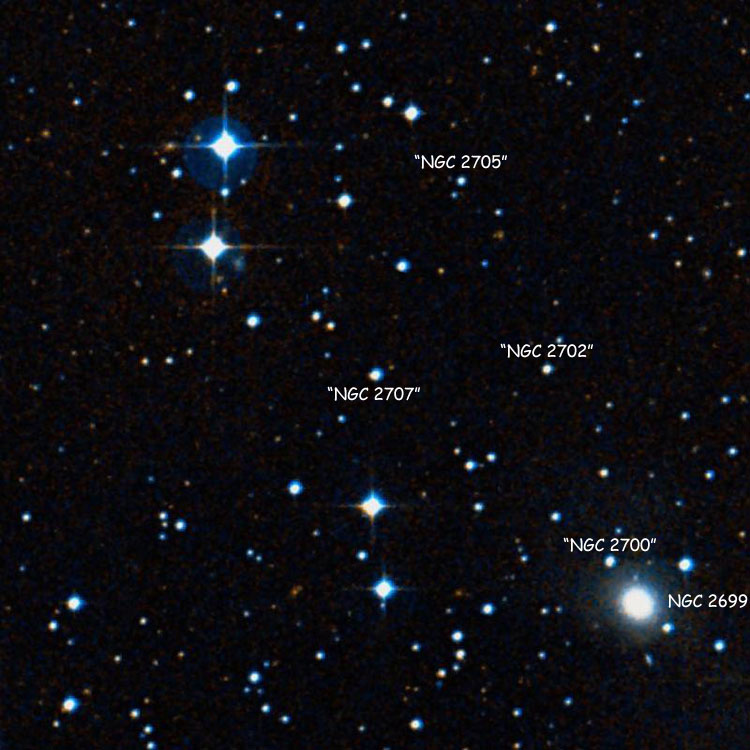
Above, a 12 arcmin wide DSS image centered on the star listed as NGC 2707
Also shown are 2699, 2700, 2702 and 2705
NGC 2708 ( = PGC 25097 = NGC 2727)
Discovered (Jan 6, 1785) by William Herschel (and later listed as NGC 2708)
Also observed (date?) by Heinrich d'Arrest (and later listed as NGC 2708)
Discovered (Mar 12, 1826) by John Herschel (and later listed as NGC 2727)
A magnitude 12.0 spiral galaxy (type Sb? pec) in Hydra (RA 08 56 08.0, Dec -03 21 37)
Historical Identification: Per Dreyer, NGC 2708 (= GC 1730, WH II 281, d'Arrest, 1860 RA 08 49 06, NPD 92 49.1) is "pretty faint, pretty small, extended, 2 stars near". The position precesses to RA 08 56 08.9, Dec -03 21 06, on the northern rim of the galaxy, the description fits and there is nothing else nearby, so the identification is certain.
Physical Information: Apparent size 2.7 by 1.4 arcmin.
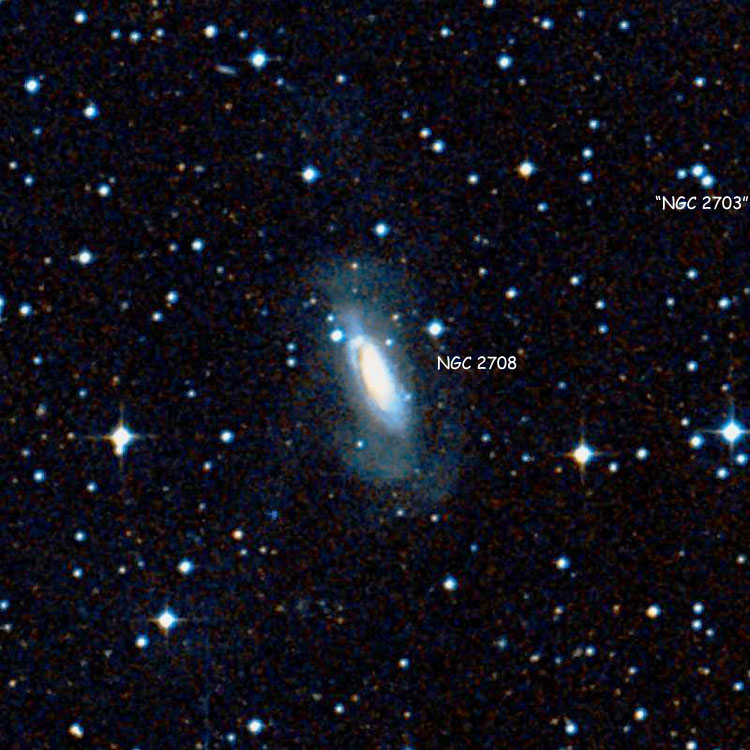
Above, a 12 arcmin wide DSS image centered on NGC 2708, also showing "NGC 2703"
Below, a 4.5 arcmin wide image of the galaxy, enhanced to show the faint outer arms
(Image Credit & © Carnegie-Irvine Galaxy Survey; used by permission)
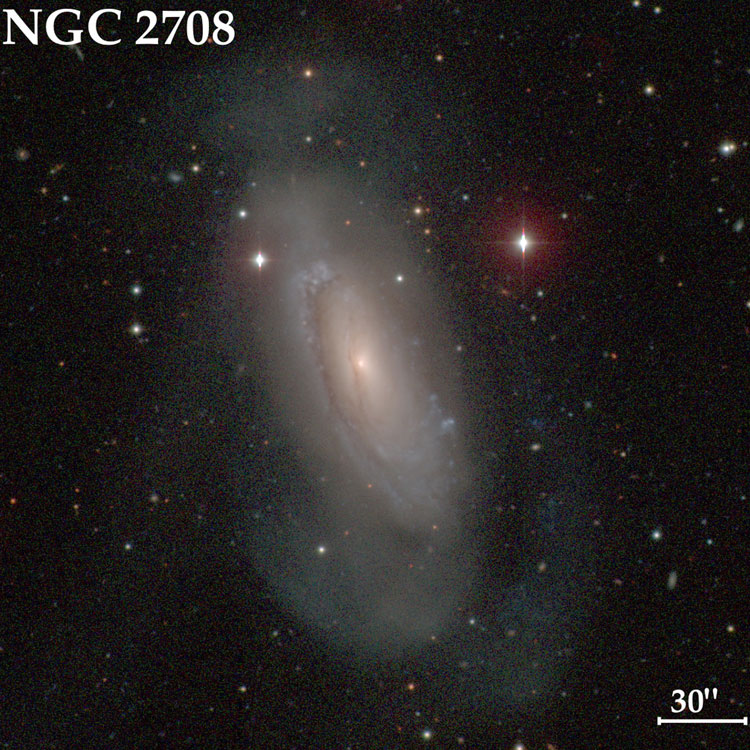
NGC 2709 (= PGC 25103)
Recorded (Jan 27, 1852) by Bindon Stoney
A magnitude 13.7 lenticular galaxy (type SB0(s)a?) in Hydra (RA 08 56 12.9, Dec -03 14 35)
Historical Identification: Per Dreyer, NGC 2709 (= GC 1722, 3rd Lord Rosse, 1860 RA 08 49 11, NPD 92 42.0) is "very faint, pretty small, a little extended, north northeast of II 281", (WH) II 281 being NGC 2708.
Discovery Notes: Although Dreyer credits the discovery to William Parsons, 3rd Earl of Rosse, he notes that many of Rosse's nebular discoveries were actually made by one of his assistants, in this case Bindon Stoney.
Physical Information: Apparent size 0.8 by 0.6 arcmin.
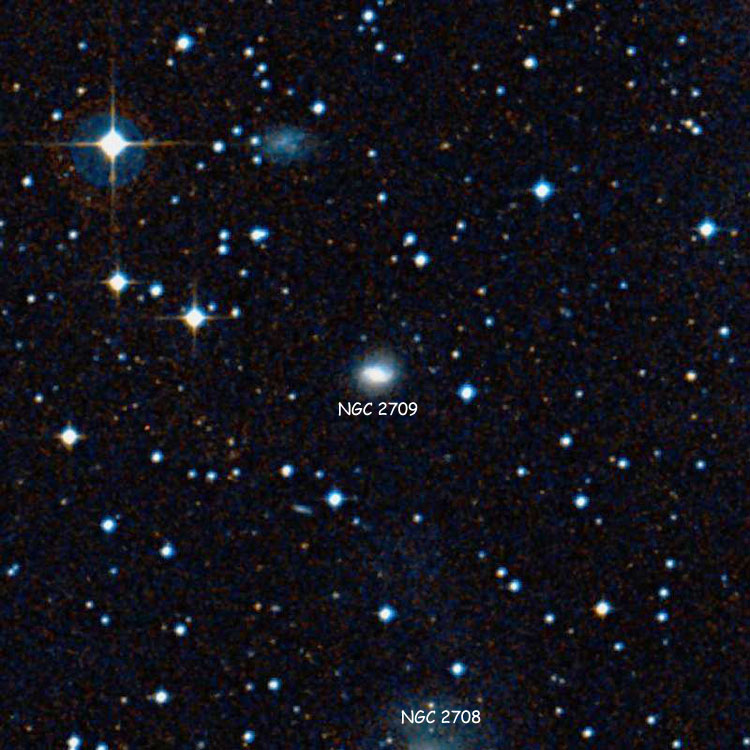
Above, a 12 arcmin wide DSS image centered on NGC 2709, also showing the northern rim of NGC 2708
Below, a 0.9 arcmin wide DSS image of the galaxy

Below, a 0.75 arcmin wide PanSTARRS image of the galaxy
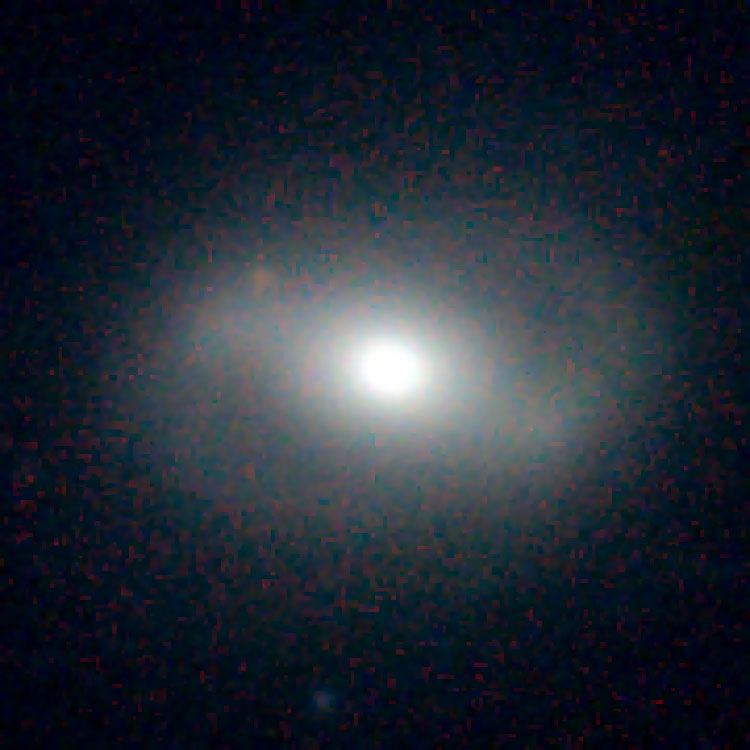
NGC 2710 (= PGC 25258)
Discovered (Mar 18, 1790) by William Herschel
A magnitude 12.9 spiral galaxy (type SBb) in Ursa Major (RA 08 59 48.4, Dec +55 42 23)
Historical Identification: Per Dreyer, NGC 2710 (= GC 1731 = WH III 841, 1860 RA 08 49 15, NPD 33 46.9) is "very faint, small".
Physical Information: Apparent size 2.0 by 1.0 arcmin.

Above, a 12 arcmin wide SDSS image centered on NGC 2710
Below, a 2.4 arcmin wide SDSS image of the galaxy

NGC 2711 (= PGC 25164)
Discovered (Mar 28, 1864) by Albert Marth
A magnitude 13.7 spiral galaxy (type SB(rs)bc? pec) in Cancer (RA 08 57 23.6, Dec +17 17 17)
Historical Identification: Per Dreyer, NGC 2711 (= GC 5441, Marth #134, 1860 RA 08 49 31, NPD 72 11) is "very faint, small, round".
Physical Information: Apparent size 0.9 by 0.6 arcmin.

Above, a 12 arcmin wide SDSS image centered on NGC 2711
Below, a 1 arcmin wide SDSS image of the galaxy

NGC 2712 (= PGC 25248)
Discovered (Mar 19, 1828) by John Herschel
A magnitude 12.1 spiral galaxy (type SB(rs)b? pec) in Lynx (RA 08 59 30.5, Dec +44 54 50)
Historical Identification: Per Dreyer, NGC 2712 (= GC 1732 = JH 540, 1860 RA 08 50 04, NPD 44 33.4) is "pretty bright, large, extended, very gradually brighter middle equivalent to 18th magnitude star".
Physical Information: Apparent size 2.8 by 1.5 arcmin.
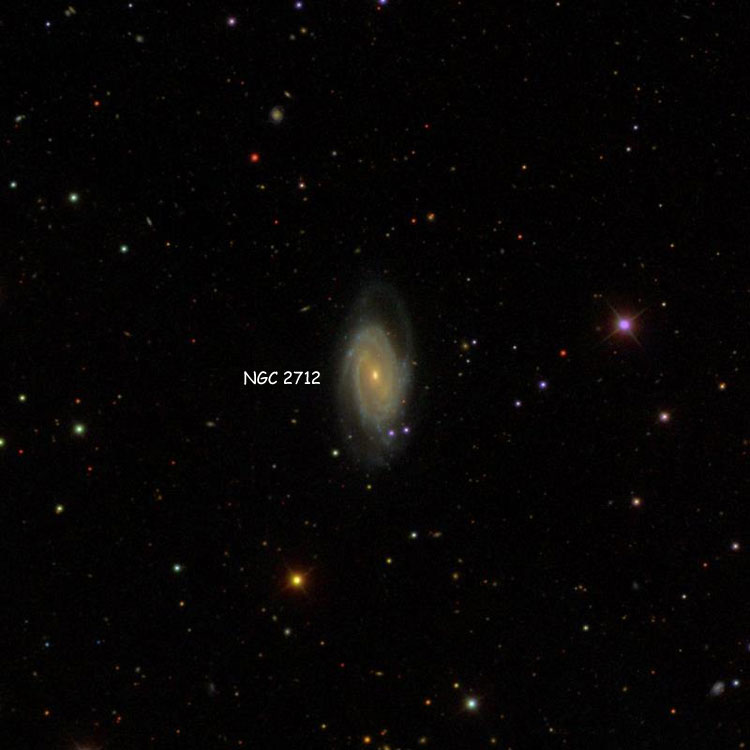
Above, a 12 arcmin wide SDSS image centered on NGC 2712
Below, a 2.4 by 3.6 arcmin wide SDSS image of the galaxy

NGC 2713 (= PGC 25161)
Discovered (Mar 3, 1864) by Albert Marth
Also observed (Mar 15, 1866) by Heinrich d'Arrest
A magnitude 11.8 spiral galaxy (type (R)SB(rs)ab) in Hydra (RA 08 57 20.5, Dec +02 55 17)
Historical Identification: Per Dreyer, NGC 2713 (= GC 5442, Marth #135, d'Arrest, 1860 RA 08 50 05, NPD 86 32.4) is "pretty bright, irregularly round, much brighter middle".
Physical Information: Apparent size 3.6 by 1.5 arcmin? Classified by the de Vaucouleurs galaxy atlas as type (R1')SB(rs)ab.

Above, a 12 arcmin wide SDSS image centered on NGC 2713
Below, a 4 arcmin wide SDSS image of the galaxy

NGC 2714 (= PGC 24959)
Discovered (Feb 4, 1835) by John Herschel
A magnitude 12.9 elliptical galaxy (type E0) in Carina (RA 08 53 29.8, Dec -59 13 02)
Historical Identification: Per Dreyer, NGC 2714 (= GC 1733 = JH 3143, 1860 RA 08 50 06, NPD 148 41.4) is "extremely faint, small, round, pretty suddenly a little brighter middle". The position precesses to RA 08 53 28.7, Dec -59 13 16, on the southwestern rim of the galaxy listed above, the description fits and there is nothing else nearby, so the identification is certain.
Warning About Images: A search for images of NGC 2714 may show an HST image of an emission and absorption nebula, but that is a mislabeled image of what is supposedly NGC 2174, but is actually a part of NGC 2175 well to the southwest of NGC 2174.)
Physical Information: Apparent size 1.1 by 1.1 arcmin.
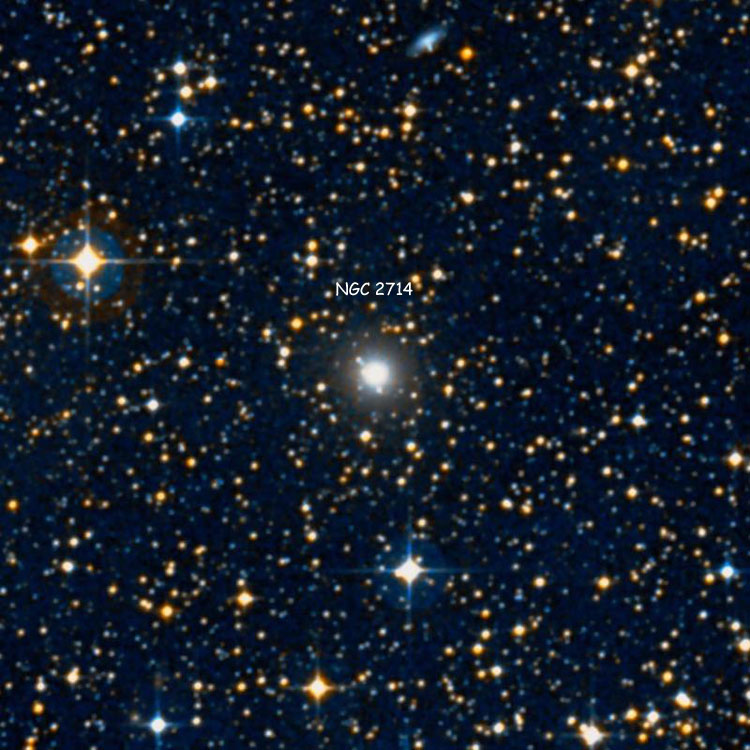
Above, a 12 arcmin wide DSS image centered on NGC 2714
Below, a 2 arcmin wide DSS image of the galaxy

NGC 2715 (= PGC 25676)
Discovered (1871) by Alphonse Borrelly
A magnitude 11.2 spiral galaxy (type SBc) in Camelopardalis (RA 09 08 06.3, Dec +78 05 07)
Historical Identification: Per Dreyer, NGC 2715 (= GC 5443, Borelly (#3), 1860 RA 08 50 09, NPD 11 22.6) is "pretty bright, large, extended".
Physical Information: Apparent size 4.8 by 1.6 arcmin.

Above, a 12 arcmin wide DSS image centered on NGC 2715
Below, a 5 arcmin wide image of the galaxy (Image Credit Jeff Hapeman/Adam Block/NOAO/AURA/NSF)

NGC 2716 (= PGC 25172)
Discovered (Mar 3, 1864) by Albert Marth
Also observed (Mar 15, 1866) by Heinrich d'Arrest
A magnitude 11.8 lenticular galaxy (type S0(r)a?) in Hydra (RA 08 57 35.9, Dec +03 05 25)
Historical Identification: Per Dreyer, NGC 2716 (= GC 5444, Marth #136, d'Arrest, 1860 RA 08 50 19, NPD 86 22.9) is "faint, small, round, much brighter middle".
Physical Information: Apparent size 1.3 by 1.0 arcmin.

Above, a 12 arcmin wide SDSS image centered on NGC 2716
Below, a 2.4 arcmin wide SDSS image of the galaxy

NGC 2717 (= PGC 25146)
Discovered (Mar 20, 1835) by John Herschel
A magnitude 12.3 lenticular galaxy (type E/S0?) in Pyxis (RA 08 57 01.1, Dec -24 40 26)
Historical Identification: Per Dreyer, NGC 2717 (= GC 1734 = JH 3144, 1860 RA 08 50 52, NPD 114 08.0) is "pretty faint, small, round, very gradualy pretty much brighter middle".
Physical Information: Apparent size 2.1 by 1.5 arcmin.

Above, a 12 arcmin wide DSS image centered on NGC 2717
Below, a 2.4 arcmin wide DSS image of the galaxy

Below, a 1 arcmin wide PanSTARRS image of the core of the galaxy
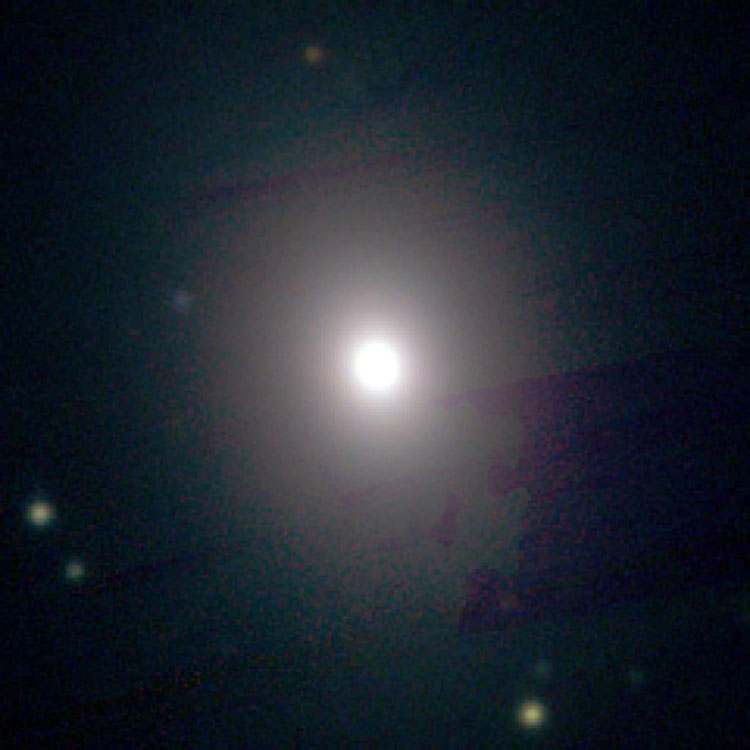
NGC 2718 (= PGC 25225)
Discovered (Mar 24, 1786) by William Herschel
Also observed (Dec 25, 1827) by John Herschel
A magnitude 11.8 spiral galaxy (type SB(rs)b?) in Hydra (RA 08 58 50.5, Dec +06 17 35)
Historical Identification: Per Dreyer, NGC 2718 (= GC 1735 = GC 1736 = JH 542 = WH II 557, 1860 RA 08 51 20, NPD 83 08.5) is "faint, pretty large, extended, among 3 stars".
Physical Information: Apparent size 2.1 by 2.1 arcmin.

Above, a 12 arcmin wide SDSS image centered on NGC 2718
Below, a 2.75 arcmin wide SDSS image of the galaxy
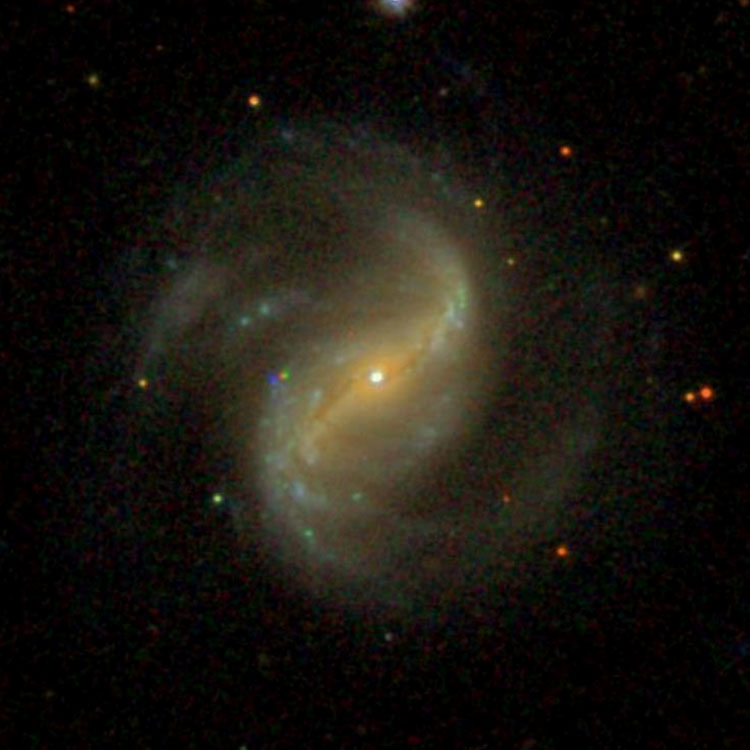
NGC 2719 (= PGC 25281, and with PGC 25284 = Arp 202)
Discovered (Mar 28, 1786) by William Herschel
Also observed (Mar 11, 1831) by John Herschel
A magnitude 13.1 irregular galaxy (type Im) in Lynx (RA 09 00 15.7, Dec +35 43 39)
Historical Identification: Per Dreyer, NGC 2719 (= GC 1737 = JH 541 = WH III 540, 1860 RA 08 51 26, NPD 53 44.1) is "very faint, small, extended 110°, 2 very faint stars involved".
Physical Information: Apparent size 1.1 by 0.3 arcmin. Recessional velocity 3075 km/sec. Interacting with PGC 25284. The pair is used by the Arp Atlas as an example of galaxies with material ejected from their nuclei.
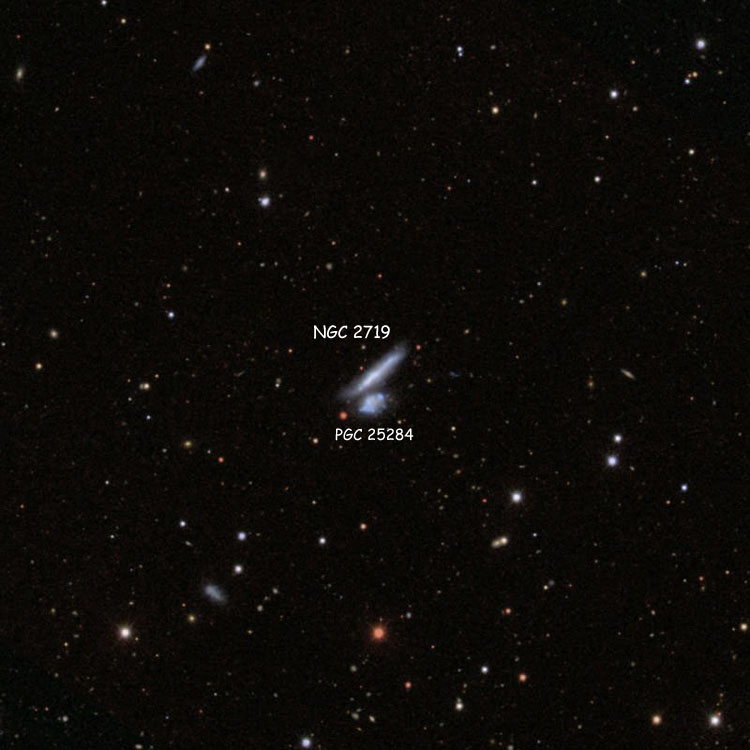
Above, a 12 arcmin wdie SDSS image centered on NGC 2719, also showing PGC 25284
Below, a 1.5 arcmin wide SDSS image of the pair of galaxies

PGC 25284 (= "NGC 2719A", and with NGC 2719 = Arp 202)
Not an NGC object but listed here since sometimes called NGC 2719A (and as part of Arp 202)
A magnitude 13.9 irregular galaxy (type Im) in Lynx (RA 09 00 15.8, Dec +35 43 14)
Physical Information: Apparent size 0.4 by 0.3 arcmin. Recessional velocity 3115 km/sec. Interacting with NGC 2719, which see for images. The pair is used by the Arp Atlas as an example of galaxies with material ejected from their nuclei.
NGC 2720 (= PGC 25238)
Discovered (Mar 10, 1864) by Albert Marth
Also observed (1876) by Wilhelm Tempel
A magnitude 12.8 lenticular galaxy (type E/S0) in Cancer (RA 08 59 08.1, Dec +11 08 57)
Historical Identification: Per Dreyer, NGC 2720 (= GC 5445, Marth #137, Tempel list I (#?), 1860 RA 08 51 30, NPD 78 18) is "faint, small, round, brighter middle".
Physical Information: Apparent size 1.1 by 1.1 arcmin.

Above, a 12 arcmin wide SDSS image centered on NGC 2720
Below, a 1.4 arcmin wide SDSS image of the galaxy

NGC 2721 (= PGC 25231)
Discovered (Feb 1, 1786) by William Herschel
Also observed (Feb 19, 1830) by John Herschel
A magnitude 12.2 spiral galaxy (type SB(rs)bc? pec) in Hydra (RA 08 58 56.5, Dec -04 54 07)
Historical Identification: Per Dreyer, NGC 2721 (= GC 1739 = JH 543 = WH II 529, 1860 RA 08 51 59, NPD 94 21.5) is "considerably faint, pretty large, round, very gradually brighter middle".
Physical Information: Apparent size 2.4 by 1.6 arcmin.

Above, a 12 arcmin wide DSS image centered on NGC 2721
Below, a 2.5 arcmin wide PanSTARRS image of the galaxy

NGC 2722 (= PGC 27221 = NGC 2733)
Discovered (Jan 6, 1785) by William Herschel (and later listed as NGC 2722)
Discovered (Mar 12, 1826) by John Herschel (and later listed as NGC 2733)
A magnitude 12.7 spiral galaxy (type Sbc) in Hydra (RA 08 58 46.2, Dec -03 42 36)
Historical Identification: Per Dreyer, NGC 2722 (= GC 1740 = WH III 264, 1860 RA 08 52 29, NPD 93 11.1) is "very faint, very small, stellar".
Physical Information: Apparent size 2.0 by 1.3 arcmin. The bottom image shows that the spiral arms of NGC 2722 nearly reach PGC 1067840, the galaxy to the east of the NGC object; but there is no apparent distortion of those arms, and nothing is known about PGC 1067840, save for its apparent size and brightness, so whether it is in any way connected with the larger galaxy is a mystery.

Above, a 12 arcmin wide DSS image centered on NGC 2722
Below, a 2.4 arcmin wide DSS image of the galaxy and PGC 1067840
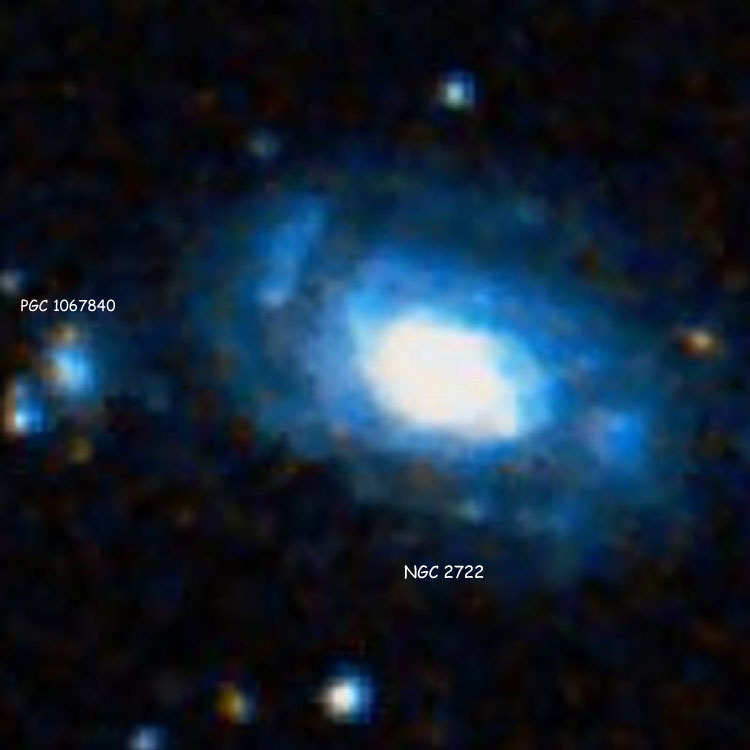
Below, a 2.25 arcmin wide PanSTARRS image of the galaxy, also showing PGC 1067840

Below, a ? arcmin wide image of part of the galaxy "pair" (Image Credit vespo09; permission requested)

NGC 2723 (= PGC 25280)
Discovered (Mar 3, 1864) by Albert Marth
A magnitude 13.2 lenticular galaxy (type S0) in Hydra (RA 09 00 14.4, Dec +03 10 40)
Historical Identification: Per Dreyer, NGC 2723 (= GC 5446, Marth #138, 1860 RA 08 53 02, NPD 86 16) is "faint, small, round".
Physical Information: Apparent size 0.8 by 0.8 arcmin.

Above, a 12 arcmin wide DSS image centered on NGC 2723
Below, a 1.6 arcmin wide SDSS image of the galaxy
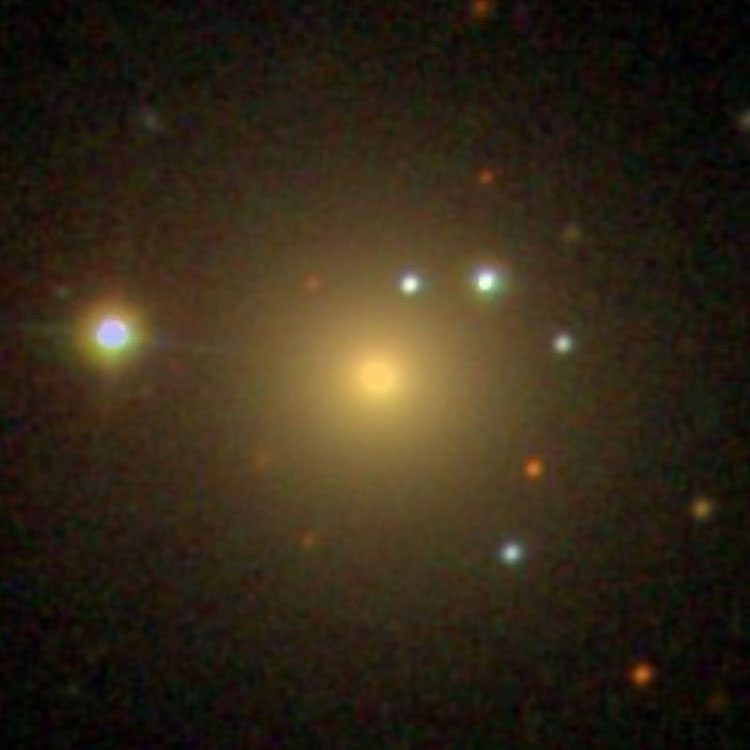
NGC 2724 (= PGC 25331)
Discovered (Feb 7, 1832) by John Herschel
A magnitude 13.6 spiral galaxy (type SBc) in Lynx (RA 09 01 01.8, Dec +35 45 44)
Historical Identification: Per Dreyer, NGC 2724 (= GC 1741 = JH 544, 1860 RA 08 53 07, NPD 53 42.7) is "extremely faint, small, stellar".
Physical Information: Apparent size 1.8 by 1.6 arcmin.

Above, a 12 arcmin wide SDSS image centered on NGC 2724
Below, a 3 arcmin wide SDSS image of the galaxy

NGC 2725 (= PGC 25332)
Discovered (Mar 10, 1864) by Albert Marth
A magnitude 13.5 spiral galaxy (type S(rs)a? pec) in Cancer (RA 09 01 03.2, Dec +11 05 54)
Historical Identification: Per Dreyer, NGC 2725 (= GC 5447, Marth #139, 1860 RA 08 53 26, NPD 78 22) is "faint, pretty large, preceding (western) of 2", the other being NGC 2728.
Physical Information: Apparent size 0.7 by 0.6 arcmin.

Above, a 12 arcmin wide SDSS image centered on NGC 2725
Below, a 1 arcmin wide SDSS image of the galaxy

NGC 2726 (= PGC 25498)
Discovered (Mar 19, 1790) by William Herschel
Also observed (Mar 8, 1832) by John Herschel
A magnitude 12.5 spiral galaxy (type Sa?) in Ursa Major (RA 09 04 56.8, Dec +59 55 58)
Historical Identification: Per Dreyer, NGC 2726 (= GC 1742 = JH 545 = WH II 834, 1860 RA 08 53 53, NPD 29 29.8) is "considerably faint, pretty small, irregularly round, extremely mottled but not resolved".
Physical Information: Apparent size 1.6 by 0.5 arcmin.

Above, a 12 arcmin wide SDSS image centered on NGC 2726
Below, a 2 arcmin wide SDSS image of the galaxy
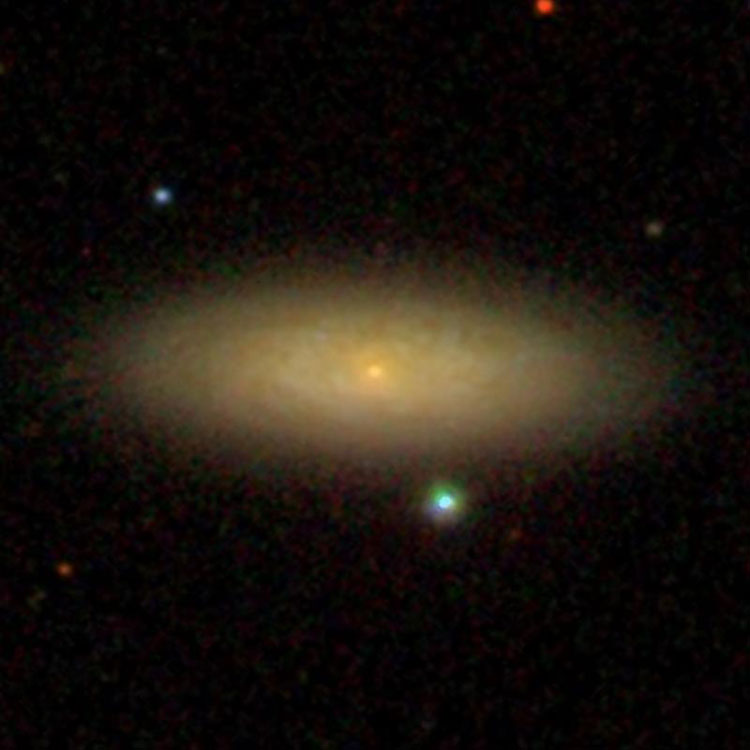
NGC 2727 (= NGC 2708 = PGC 25097)
Discovered (Jan 6, 1785) by William Herschel (and later listed as NGC 2708)
Also observed (date?) by Heinrich d'Arrest (and later listed as NGC 2708)
Discovered (Mar 12, 1826) by John Herschel (and later listed as NGC 2727)
A magnitude 12.0 spiral galaxy (type Sb) in Hydra (RA 08 56 08.0, Dec -03 21 37)
Historical Identification: Per Dreyer, NGC 2727 (= GC 1743 = JH 546, 1860 RA 08 54 02, NPD 92 50.3) is "very faint, large, round, brighter middle". (The next iteration of this page will discuss the proof that this is a duplicate observation of NGC 2708.)
Physical Information: Given the duplicate entry, see NGC 2708 for anything else.
NGC 2728 (= PGC 25360)
Discovered (Mar 10, 1864) by Albert Marth
A magnitude 13.6 spiral galaxy (type SAB(rs)bc?) in Cancer (RA 09 01 40.9, Dec +11 04 59)
Historical Identification: Per Dreyer, NGC 2728 (= GC 5448, Marth #140, 1860 RA 08 54 03, NPD 78 22) is "very faint, pretty large, a little extended, eastern of 2", the other being NGC 2725.
Physical Information: Apparent size 1.1 by 0.8 arcmin.

Above, a 12 arcmin wide SDSS image centered on NGC 2728
Below, a 1.2 arcmin wide image of the galaxy

NGC 2729 (= PGC 25352)
Discovered (Mar 3, 1864) by Albert Marth
A magnitude 13.4 lenticular galaxy (type (R)S0?) in Hydra (RA 09 01 28.6, Dec +03 43 14)
Historical Identification: Per Dreyer, NGC 2729 (= GC 5449, Marth #141, 1860 RA 08 54 03, NPD 85 44) is "very faint, very small, round".
Physical Information: Apparent size 0.8 by 0.5 arcmin.

Above, a 12 arcmin wide SDSS image centered on NGC 2729
Below, a 2 arcmin wide image of the galaxy

NGC 2730 (= PGC 25384)
Discovered (Mar 28, 1864) by Albert Marth
A magnitude 13.0 spiral galaxy (type SBdm) in Cancer (RA 09 02 15.8, Dec +16 50 18)
Historical Identification: Per Dreyer, NGC 2730 (= GC 5450, Marth #142, 1860 RA 08 54 26, NPD 72 35) is "very faint, large, round".
Physical Information: Apparent size 1.7 by 1.3 arcmin.

Above, a 12 arcmin wide SDSS image centered on NGC 2730
Below, a 2 arcmin wide SDSS image of the galaxy

NGC 2731 (= PGC 25376)
Discovered (Mar 3, 1864) by Albert Marth
A magnitude 13.7 spiral galaxy (type Sc? pec) in Cancer (RA 09 02 08.4, Dec +08 18 06)
Historical Identification: Per Dreyer, NGC 2731 (= GC 5451, Marth #143, 1860 RA 08 54 35, NPD 81 08) is "faint, very small, round".
Physical Information: Apparent size 0.8 by 0.5 arcmin.
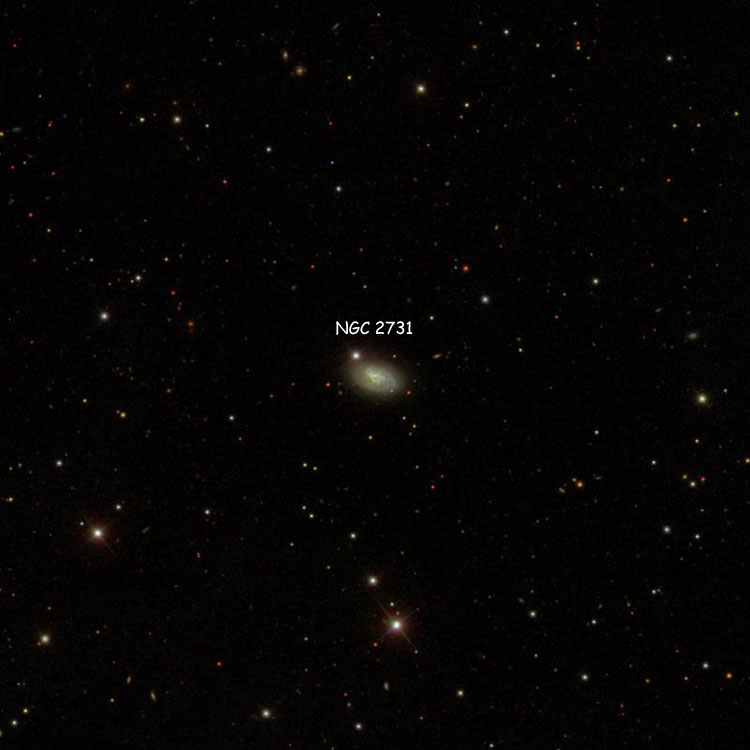
Above, a 12 arcmin wide SDSS image centered on NGC 2731
Below, a 1.4 arcmin wide SDSS image of the galaxy
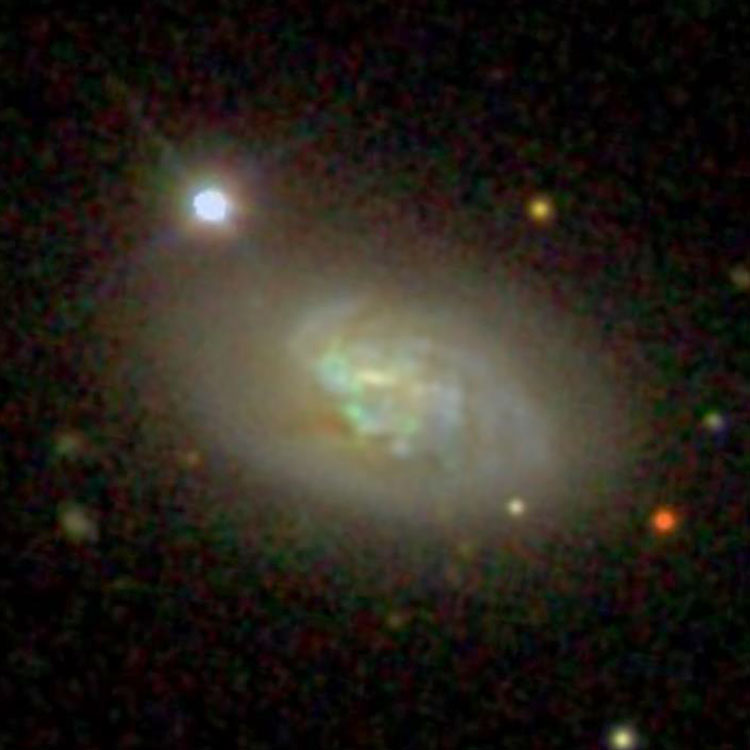
NGC 2732 (= PC 25999)
Discovered (Sep 2, 1828) by John Herschel
Also observed (date?) by Heinrich d'Arrest
A magnitude 11.9 lenticular galaxy (type SB0/a?) in Camelopardalis (RA 09 13 24.8, Dec +79 11 15)
Historical Identification: Per Dreyer, NGC 2732 (= GC 1738 = JH 539, d'Arrest, 1860 RA 08 54 42, NPD 10 15.0) is "pretty bright, small, extended 45°, 13th magnitude star to northeast".
Physical Information: Apparent size 2.1 by 0.9 arcmin.

Above, a 12 arcmin wide DSS image centered on NGC 2732
Below, a 1.75 arcmin wide DSS image of the galaxy
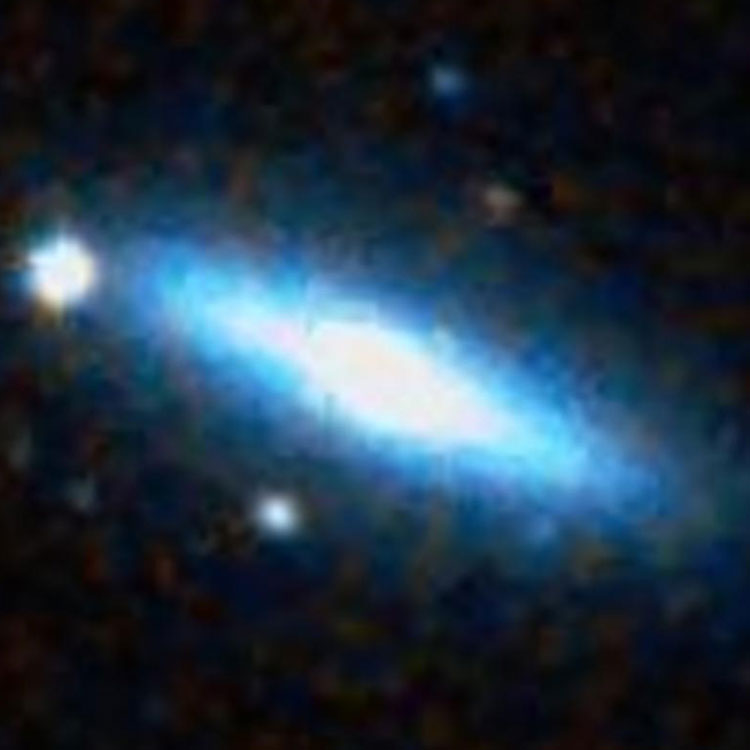
Below, a 1.5 arcmin wide PanSTARRS image of the galaxy
(The yellowish smudge to the right of the core is an image defect)

NGC 2733 (= NGC 2722 = PGC 25221)
Discovered (Jan 6, 1785) by William Herschel (and later listed as NGC 2722)
Discovered (Mar 12, 1826) by John Herschel (and later listed as NGC 2733)
A magnitude 12.7 spiral galaxy (type Sbc) in Hydra (RA 08 58 46.2, Dec -03 42 36)
Historical Identification: Per Dreyer, NGC 2733 (= GC 1744 = JH 547, 1860 RA 08 55 01, NPD 93 10.9) is "extremely faint, round". (The next iteration of this page will discuss the fact that this is a duplicate observation of NGC 2722.)
Physical Information: Given the duplicate entry, see NGC 2722 for anything else.
NGC 2734 (= PGC 25413)
Discovered (Mar 28, 1864) by Albert Marth
A magnitude 15.5 elliptical galaxy (type E0?) in Cancer (RA 09 03 01.6, Dec +16 51 49)
Historical Identification: Per Dreyer, NGC 2734 (= GC 5452, Marth #144, 1860 RA 08 55 11, NPD 72 33) is "extremely faint, very small, round".
Physical Information: Apparent size 0.6 by 0.5 arcmin?
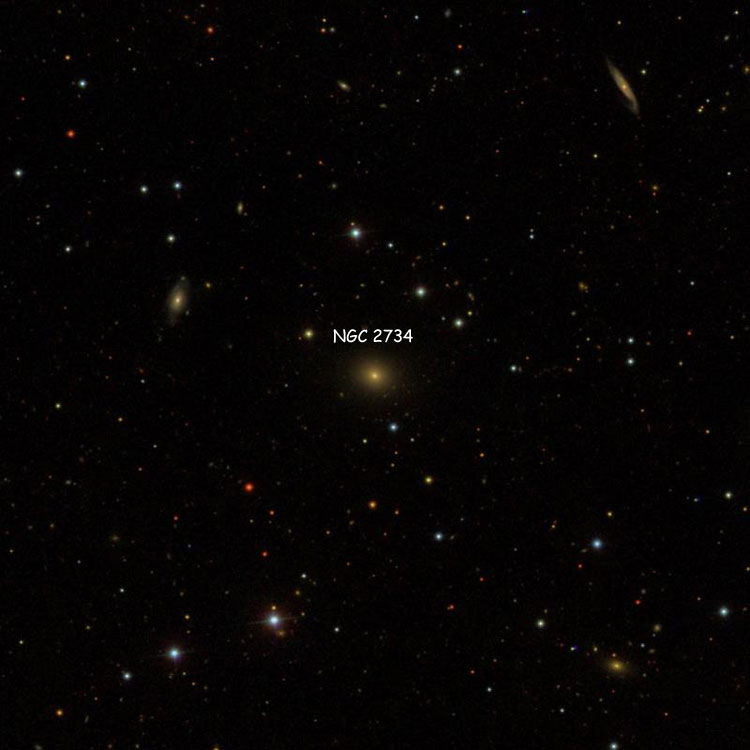
Above, a 12 arcmin wide SDSS image centered on NGC 2734
Below, a 1 arcmin wide SDSS image of the galaxy

NGC 2735 (= PGC 25399, and with PGC 25402 = Arp 287)
Discovered (Feb 26, 1878) by Édouard Stephan
A magnitude 13.3 spiral galaxy (type SAB(rs)b? pec) in Cancer (RA 09 02 38.6, Dec +25 56 04)
Historical Identification: Per Dreyer, NGC 2735 (Stephan list IX (#18), 1860 RA 08 55 23, NPD 63 31.0) is "a small (faint) star involved in very faint, very small nebula, extended east-west".
Physical Information: Gravitationally interacting with PGC 25402. Based on a recessional velocity of 2450 km/sec, NGC 2735 is about 115 million light years away, in good agreement with a redshift-independent distance estimate of 120 million light years. Given that and its apparent size of 1.2 by 0.4 arcmin, it is about 40 thousand light years across. Used (with PGC 25402) by the Arp Atlas as an example of galaxies with the appearance of wind effects.
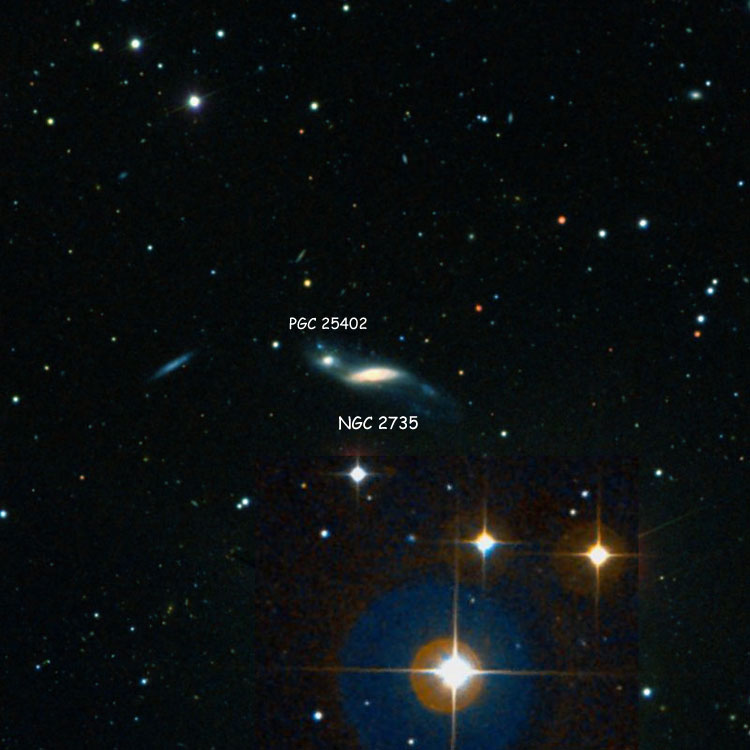
Above, a 12 arcmin wide SDSS/DSS composite image centered on NGC 2735, also showing PGC 25402
Below, a 2.7 by 1.8 arcmin wide SDSS image of the pair

Below, a 2.4 arcmin wide SDSS image of the pair

PGC 25402 (= "NGC 2735A", and with NGC 2735 = Arp 287)
Not an NGC object but listed her since sometimes called NGC 2735A, and as part of Arp 287
A magnitude 15.3 irregular galaxy (type Im pec) in Cancer (RA 09 02 41.9, Dec +25 56 18)
Physical Information: Apparent size 0.4 by 0.2 arcmin. Involved with and used with NGC 2735 (which see for images) by the Arp Atlas as an example of galaxies with the appearance of wind effects.
NGC 2736, Herschel's Ray = the Pencil Nebula
Discovered (Mar 1, 1835) by John Herschel
An emission nebula in Vela (RA 09 00 16.0, Dec -45 56 42)
Historical Identification: Per Dreyer, NGC 2736 (= GC 1745 = JH 3145, 1860 RA 08 55 31, NPD 135 20.9) is "a remarkable object, most extremely faint, very large, very very much extended 19°".
Physical Information: NGC 2736 is a bright, linear emission nebula nearly half a degree in extent, but mostly only a couple of arcmin wide. A fainter "shadow" of the ray lies to its west. As with many linear nebulae, NGC 2736 is probably part of an expanding supernova remnant (in this case the Vela Supernova Remnant), but it could a shock wave passing through the interstellar medium as a result of the supernova. NGC 2736 is moving through the interstellar medium at 400 thousand miles an hour, and even at its approximately 815 light year distance, should have a noticeable change in its position relative to the background stars within a human lifetime.

Above, a half degree wide DSS image centered near NGC 2736
Below, a 2.25 by 3.25 arcmin wide false-color image of the supernova remnant (Image Credit ESO)
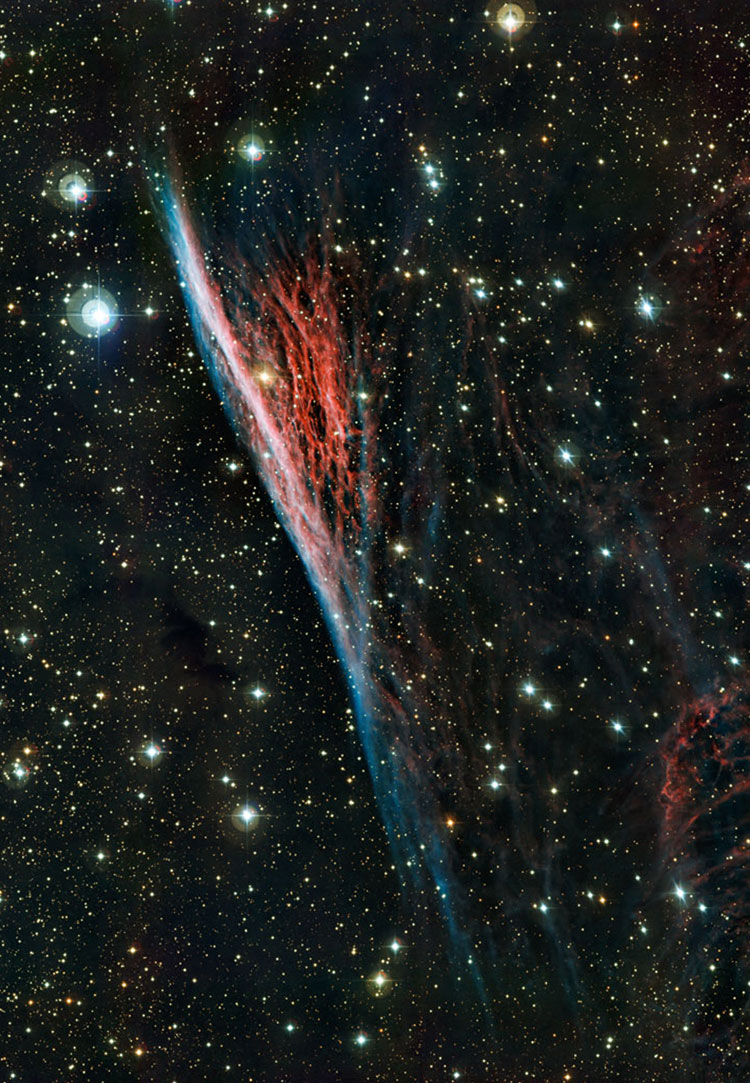
NGC 2737 (= PGC 25453)
Discovered (Feb 23, 1863) by Heinrich d'Arrest
A magnitude 14.1 lenticular galaxy (type SB0(s)a?) in Cancer (RA 09 03 59.7, Dec +21 54 24)
Historical Identification: Per Dreyer, NGC 2737 (= GC 1747, d'Arrest, 1860 RA 08 55 56, NPD 67 32.5) is "very faint, very small, part of a double nebula with the following entry", that being NGC 2738.
Physical Information: Apparent size 0.9 by 0.4 arcmin. Recessional velocity 3165 km/sec. Since NGC 2737 and 2738 have similar recessional velocities, they are probably at about the same distance from us; and if so, they may be a physical pair.
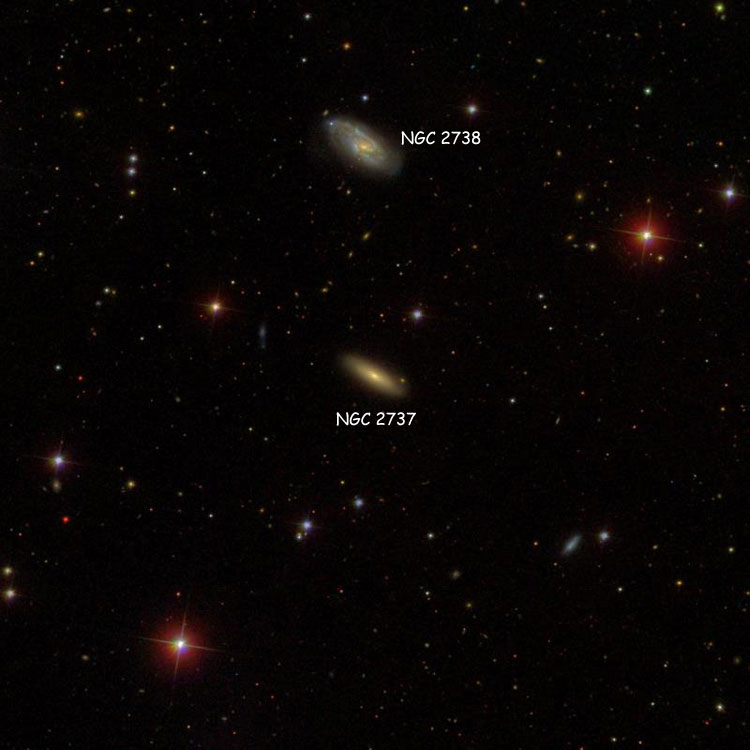
Above, a 12 arcmin wide SDSS image centered on NGC 2737, also showing NGC 2738
Below, a 1.4 arcmin wide SDSS image of the galaxy

NGC 2738 (= PGC 25454)
Discovered (Feb 23, 1863) by Heinrich d'Arrest
A magnitude 13.1 spiral galaxy (type Sbc?) in Cancer (RA 09 04 00.5, Dec +21 58 03)
Historical Identification: Per Dreyer, NGC 2738 (= GC 1746, d'Arrest, 1860 RA 08 55 57, NPD 67 28.8) is "pretty bright, small, irregular figure, part of a double nebula with the preceding entry", that being NGC 2737.
Physical Information: Apparent size 1.4 by 0.6 arcmin. Recessional velocity 3110 km/sec. Since NGC 2738 and 2737 have similar recessional velocities, they are probably at about the same distance from us; and if so, they may be a physical pair.
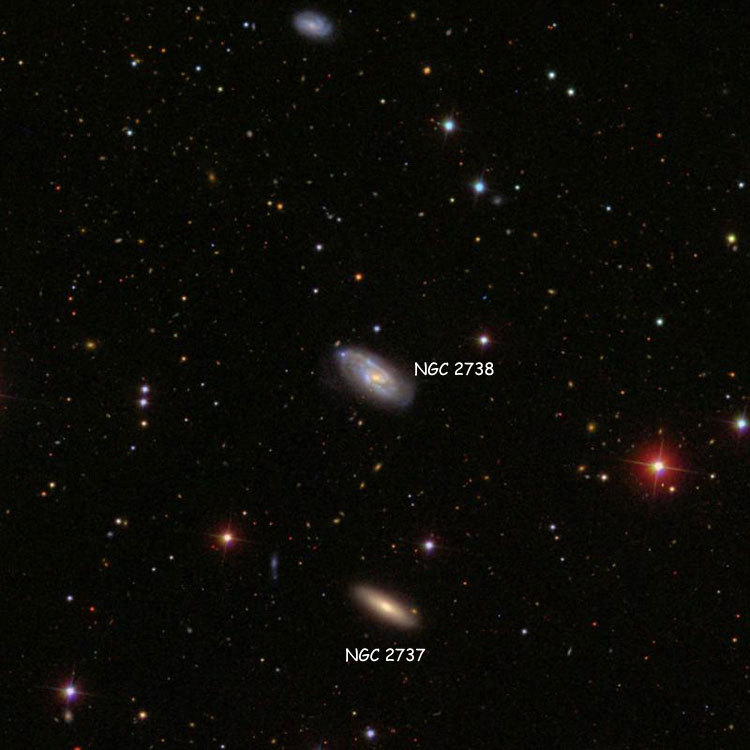
Above, a 12 arcmin wide SDSS image centered on NGC 2738, also showing NGC 2737
Below, a 1.6 arcmin wide SDSS image of the galaxy

NGC 2739 (= PGC 25530)
Discovered (Feb 18, 1855) by R. J. Mitchell
A magnitude 14.7 lenticular galaxy (type SB0/a?) in Ursa Major (RA 09 06 02.8, Dec +51 44 41)
Historical Identification: Per Dreyer, NGC 2739 (= GC 1749, 3rd Lord Rosse, 1860 RA 08 56 04, NPD 37 40) is "very faint, small, round, northwest of h 549", (JH) 549 being NGC 2740.
Discovery Notes: Although Dreyer credits the discovery to William Parsons, 3rd Earl of Rosse, he notes that many of Rosse's nebular discoveries were actually made by one of his assistants, in this case R. J. Mitchell.
Physical Information: Apparent size 0.9 by 0.2 arcmin. Recessional velocity 8855 km/sec. Since NGC 2739 and 2740 have nearly the same recessional velocity and are in nearly the same direction, they are probably a physical pair. However, given their relative lack of distortion, they are probably not quite as close as they appear, and most likely one is a little behind or in front of the other.

Above, a 12 arcmin wide SDSS image centered near NGC 2739 and 2740
Below, a 1.5 arcmin wide SDSS image of the pair

NGC 2740 (= PGC 25531)
Discovered (Feb 17, 1831) by John Herschel
A magnitude 14.0 spiral galaxy (type SB(rs)ab?) in Ursa Major (RA 09 06 05.0, Dec +51 44 07)
Historical Identification: Per Dreyer, NGC 2740 (= GC 1748, JH 549, 1860 RA 08 56 06, NPD 37 41.4) is "very faint, pretty small, round".
Physical Information: Apparent size 1.0 by 0.9 arcmin. Recessional velocity 8850 km/sec. Since NGC 2739 (which see for images) and 2740 have nearly the same recessional velocity and are in nearly the same direction, they are probably a physical pair. However, given their relative lack of distortion, they are probably not quite as close as they appear, and most likely one is a little behind or in front of the other.
NGC 2741 (= PGC 25425)
Discovered (Mar 28, 1864) by Albert Marth
A magnitude 15.0 spiral galaxy (type SBbc? pec) in Cancer (RA 09 03 16.6, Dec +18 15 40)
Historical Identification: Per Dreyer, NGC 2741 (= GC 5453, Marth #145, 1860 RA 08 56 23, NPD 71 11) is "very faint, western of 2", the other being NGC 2745.
Physical Information: Apparent size 0.4 by 0.2 arcmin?

Above, a 12 arcmin wide SDSS image centered on NGC 2741
Below, a 0.75 arcmin wide SDSS image of the galaxy
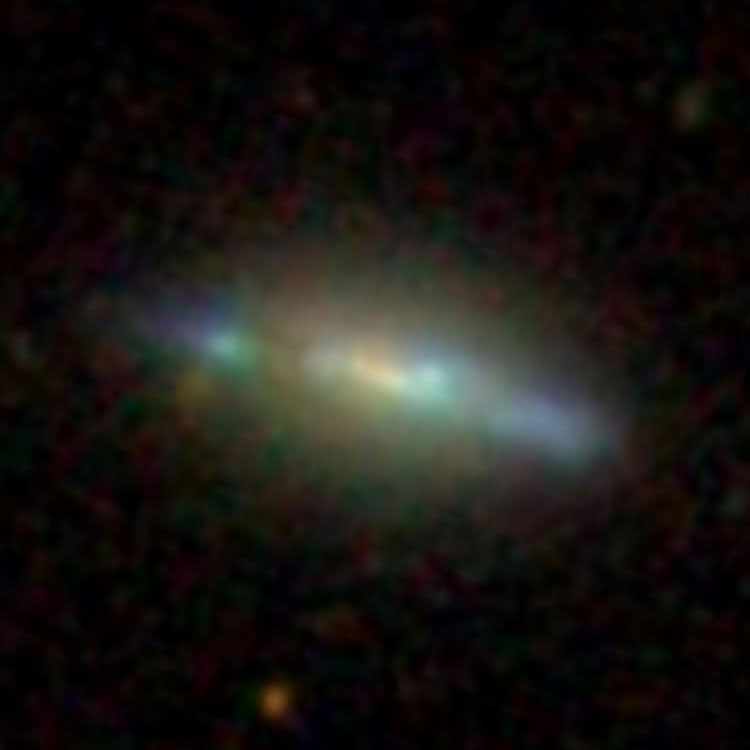
NGC 2742 (= PGC 25640, but not = NGC 2816)
Discovered (Mar 19, 1790) by William Herschel
Also observed (Mar 8, 1832) by John Herschel
A magnitude 11.4 spiral galaxy (type Sc) in Ursa Major (RA 09 07 33.6, Dec +60 28 46)
Historical Identification: Per Dreyer, NGC 2742 (= GC 1750 = JH 550 = WH I 249, 1860 RA 08 56 28, NPD 28 57.9) is "considerably bright, considerably large, extended 90°, extremely mottled but not resolved".
Why Is NGC 2816 Mentioned Here?: The identity of NGC 2816 was long unknown, and (per Corwin) one of the earlier guesses at its identity equated it with NGC 2742. And although it has since been shown (by Steinicke) that NGC 2816 is actually an erroneous observation of NGC 2820, the earlier incorrect "connection" to NGC 2742 may crop up from time to time (as it did on this page, until Corwin revised his notes to reflect the error). So the " not equal" in the title for this entry is a warning about that mistake.
Physical Information: Apparent size 3.0 by 1.5 arcmin.
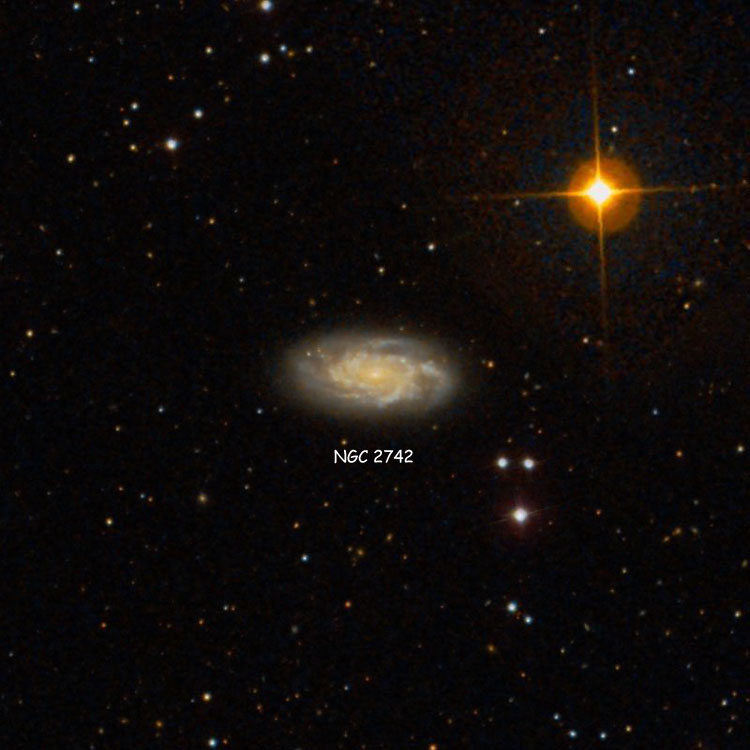
Above, a 12 arcmin wide SDSS/DSS composite image centered on NGC 2742
Below, a 3.75 arcmin wide SDSS image of the galaxy
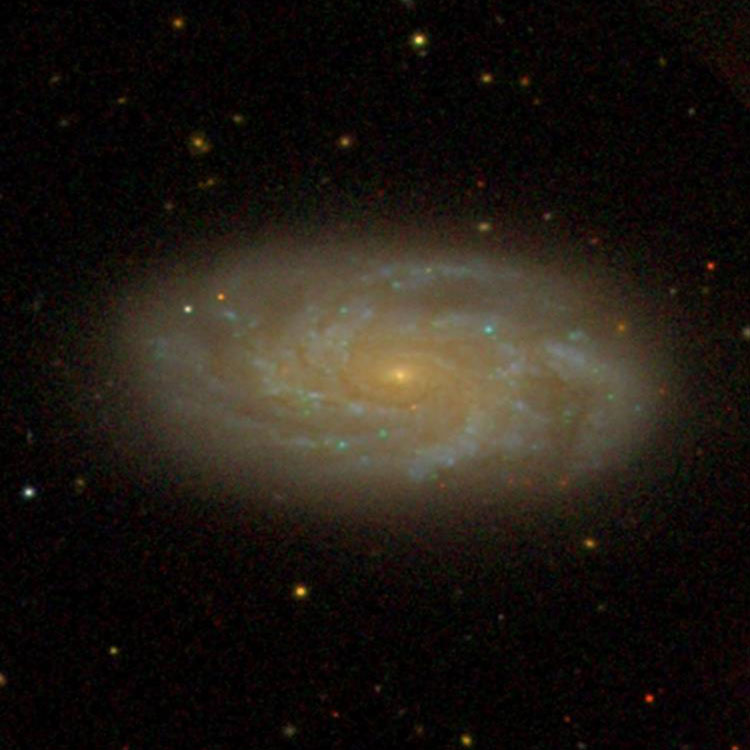
PGC 25836 (= "NGC 2742A")
Not an NGC object but listed here since sometimes called NGC 2742A
A magnitude 13.2 spiral galaxy (type SBb? pec) in Ursa Major (RA 09 09 58.1, Dec +62 14 50)
Physical Information: Apparent size 1.6 by 0.6 arcmin? It appears that PGC 25836 is gravitationally interacting with PGC 2632752, as there are faint extensions of both galaxies that appear to be related, and they have nearly identical recessional velocities. As a result, the smaller galaxy is labeled in the wide-field image below, and discussed in the following entry. (Vr, apparent size, physical size to be added in next iteration of this page)

Above, a 12 arcmin wide SDSS image centered on PGC 25836, also showing PGC 2632752
Below, a 2 arcmin wide SDSS image of PGC 25836

PGC 2632752
Not an NGC object but listed here since it is probably interacting with PGC 25836
A magnitude 16(?) galaxy (type E/SB0? pec) in Ursa Major (RA 09 10 05.9, Dec +62 13 00)
Physical Information: Almost certainly interacting with PGC 25836, based on their peculiar appearance and nearly identical recessional velocities. As shown in the wide-field image below, there appears to be faint clouds surrounding the larger galaxy and trailing down to the southeast, toward the smaller one, and a faint counter-tail stretching to the south of PGC 2632752 (that being the basis of "pec" added to its type, above). Note: The third galaxy in the region, PGC 2632834, has a recessional velocity of more than 37,000 km/sec, is a much more distant background object, and therefore shows no sign of interaction with the other two galaxies. (Vr, apparent size, physical size to be added in next iteration of this page)
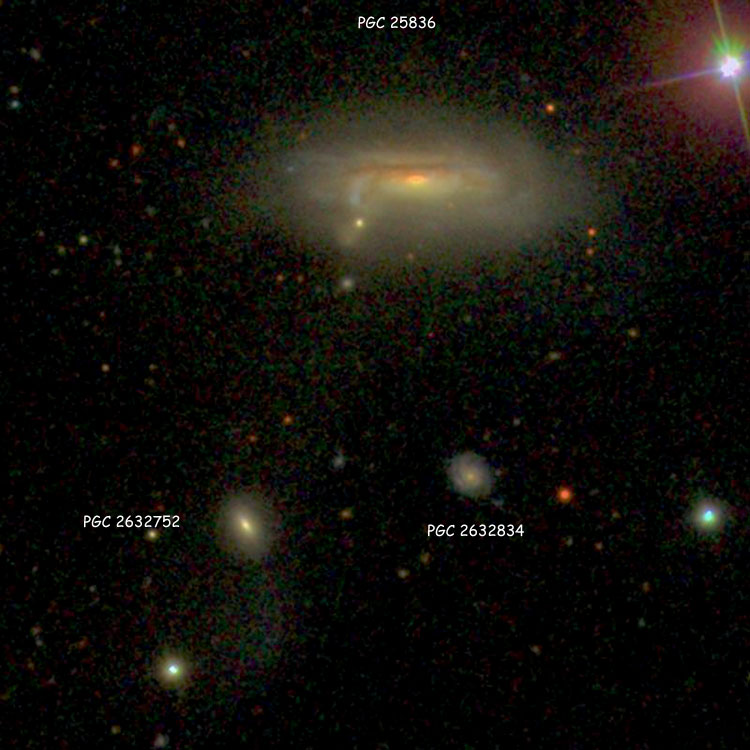
Above, a 4 arcmin wide SDSS image of PGC 2632752 and PGC 25836, also showing PGC 2632834
(See PGC 25836 for a 12 arcmin wide image of the region)
Below, a 0.5 arcmin wide SDSS image of PGC 2632752

NGC 2743 (= PGC 25496)
Discovered (Feb 22, 1787) by William Herschel
A magnitude 13.6 spiral galaxy (type Sd) in Cancer (RA 09 04 54.1, Dec +25 00 14)
Historical Identification: Per Dreyer, NGC 2743 (= GC 1751 = WH III 608, 1860 RA 08 56 34, NPD 64 26.9) is "extremely faint, small, round, very little brighter middle".
Physical Information: Apparent size 1.1 by 0.8 arcmin.

Above, a 12 arcmin wide SDSS image centered on NGC 2743
Below, a 1.6 arcmin wide SDSS image of the galaxy

NGC 2744 (= PGC 25480)
Discovered (Mar 21, 1784) by William Herschel
Also observed (Mar 25, 1827) by John Herschel
A magnitude 13.5 spiral galaxy (type SBb pec) in Cancer (RA 09 04 39.0, Dec +18 27 52)
Historical Identification: Per Dreyer, NGC 2744 (= GC 1752 = JH 551 = WH III 60, 1860 RA 08 56 43, NPD 70 59.2) is "very faint, small, round, mottled but not resolved, double star near".
Physical Information: Apparent size 1.6 by 1.2 arcmin. As noted in the following entry, the bright southern extension of this distorted galaxy is sometimes referred to as PGC 200248 or "NGC 2744A". However, although it may be a remnant of a galactic collision, it appears more likely to be a distended extension of the resulting chaos than a truly separate object. There is also a very long, very faint extension to the north.

Above, a 12 arcmin wide SDSS image centered on NGC 2744
Below, a 3.6 arcmin wide SDSS image enhanced to show its faint northern extension

Below, a 2 arcmin wide SDSS image of the galaxy, also showing "PGC 200248"
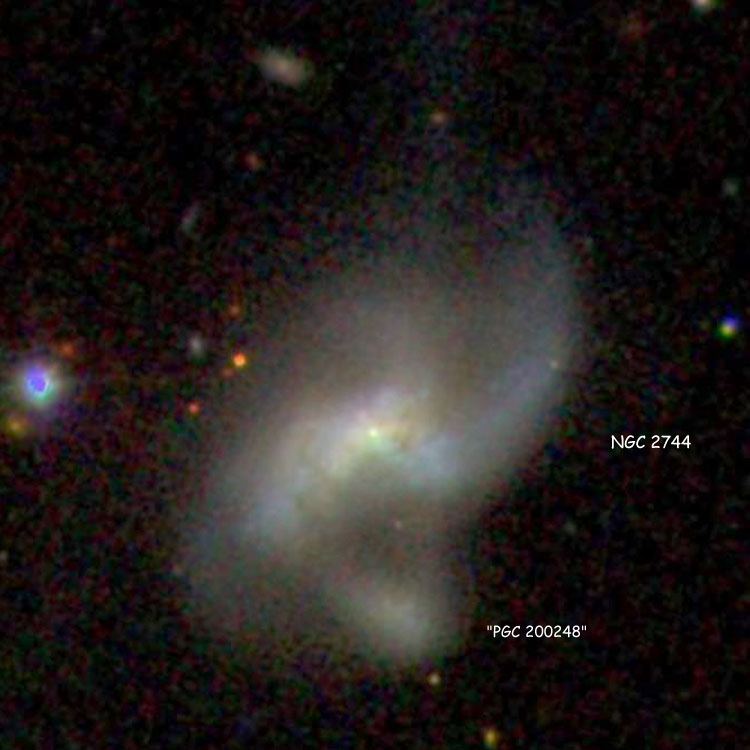
PGC 200248 (= "NGC 2744A" and/or "NGC 2744B")
Not an NGC object but listed here since sometimes called NGC 2744A or NGC 2744B
A magnitude 15.7 galaxy? (type SBab? pec) in Cancer (RA 09 04 38.7, Dec +18 27 23)
Warning About Non-Standard Designations: As the two different letters sometimes attached to an NGC number should suggest, using either NGC 2744A or NGC 2744B to describe an object such as PGC 200248 is almost certain to cause confusion, and despite their frequent misuse, such non-standard designations should never be used.
Physical Information: Apparent size 0.2 by 0.2 arcmin? More likely to be a distended extension of NGC 2744 (which see for images) than an actual galaxy.
NGC 2745 (= PGC 25478)
Discovered (Mar 28, 1864) by Albert Marth
A magnitude 14.6 lenticular galaxy (type SB0?) in Cancer (RA 09 04 39.3, Dec +18 15 26)
Historical Identification: Per Dreyer, NGC 2745 (= GC 5454, Marth #146, 1860 RA 08 56 45, NPD 71 12) is "extremely faint, very small, stellar, eastern of 2", the other being NGC 2741.
Physical Information: Apparent size 0.4 by 0.2 arcmin.

Above, a 12 arcmin wide SDSS image centered on NGC 2745
Below, a 0.75 arcmin wide SDSS image of the galaxy
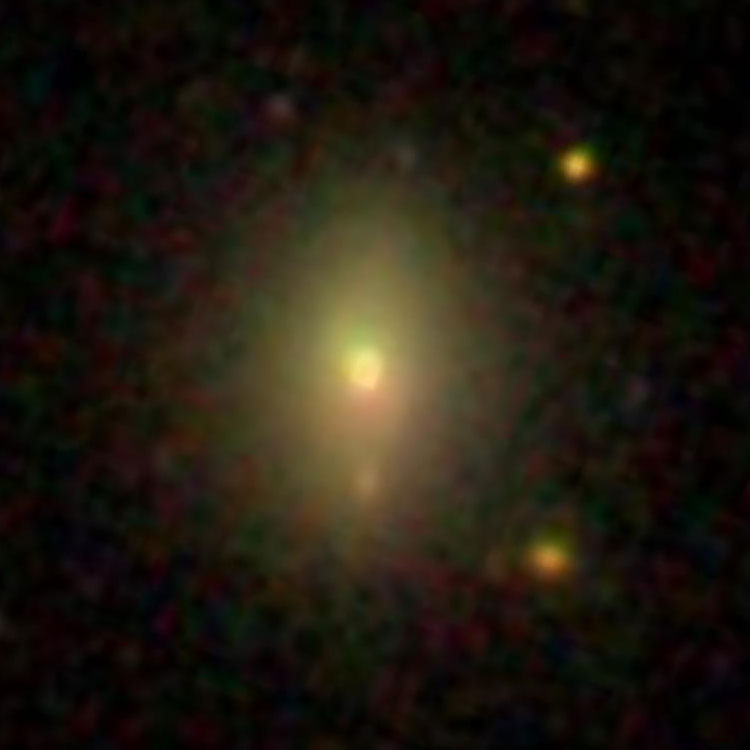
NGC 2746 (= PGC 25533)
Discovered (Mar 10, 1790) by William Herschel
Also observed (Mar 5, 1828) by John Herschel
A magnitude 13.1 spiral galaxy (type SB(rs)a?) in Lynx (RA 09 05 59.5, Dec +35 22 39)
Historical Identification: Per Dreyer, NGC 2746 (= GC 1754 = JH 552 = WH III 825, 1860 RA 08 57 15, NPD 54 03.9) is "extremely faint, small, round, very gradually a little brighter middle, 12th magnitude star 50 arcsec to north northwest".
Physical Information: Apparent size 1.6 by 1.5 arcmin?

Above, a 12 arcmin wide SDSS image centered on NGC 2746
Below, a 2.4 arcmin wide SDSS image of the galaxy
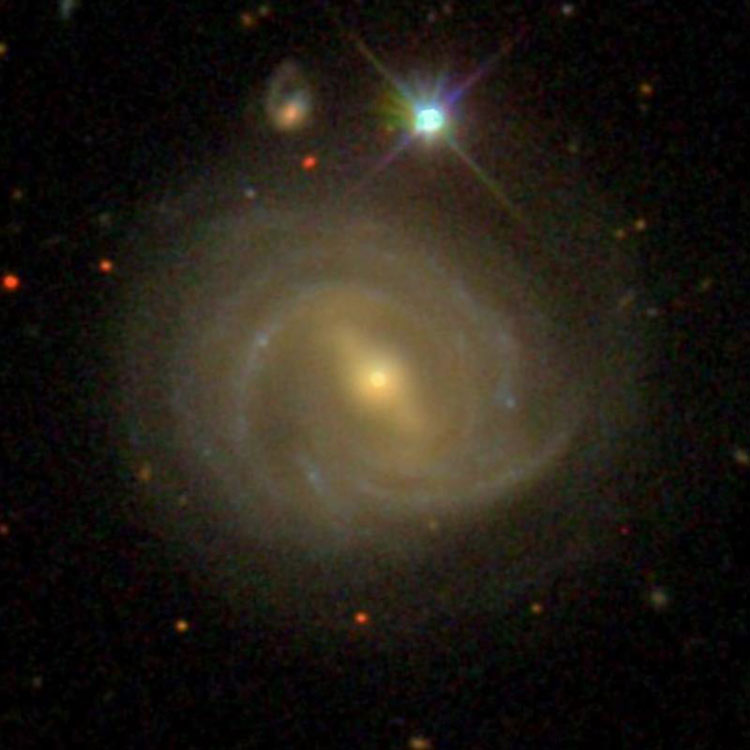
NGC 2747 (= PGC 25507)
Discovered (Mar 29, 1865) by Albert Marth
A magnitude 14.5 lenticular galaxy (type SB0? pec) in Cancer (RA 09 05 18.4, Dec +18 26 32)
Historical Identification: Per Dreyer, NGC 2747 (= GC 5455, Marth #147, 1860 RA 08 57 23, NPD 71 00) is "very faint, very small, stellar".
Physical Information: Apparent size 0.4 by 0.2 arcmin.
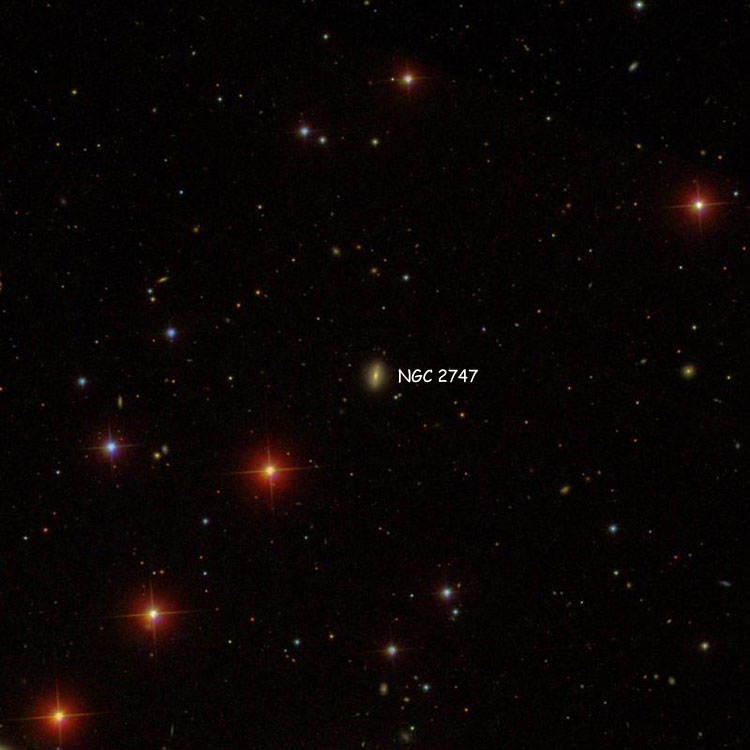
Above, a 12 arcmin wide SDSS image centered on NGC 2747
Below, a 0.75 arcmin wide SDSS image of the galaxy
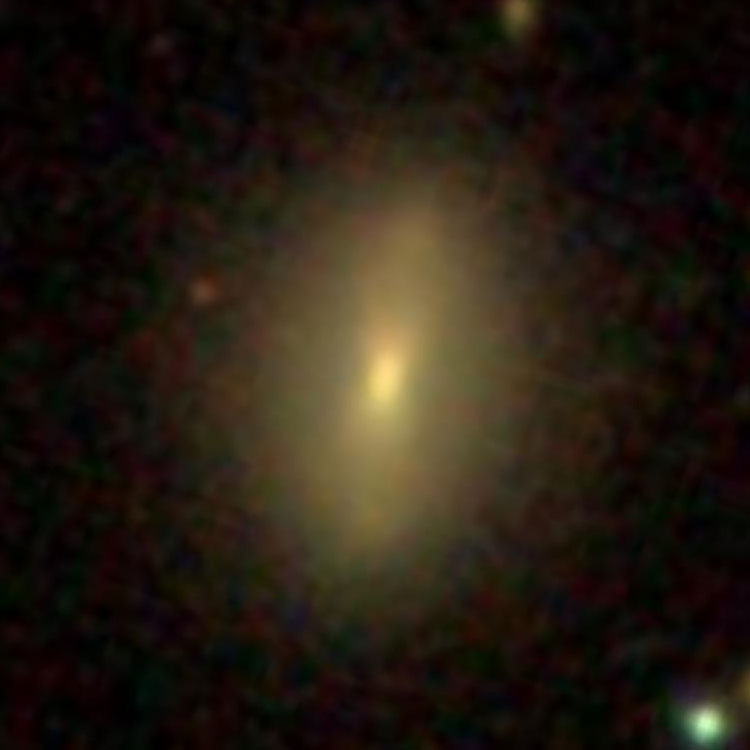
NGC 2748 (= PGC 26018)
Discovered (Sep 2, 1828) by John Herschel
A magnitude 11.7 spiral galaxy (type Sbc) in Camelopardalis (RA 09 13 43.1, Dec +76 28 31)
Historical Identification: Per Dreyer, NGC 2748 (= GC 1753 = JH 548, 1860 RA 08 57 27, NPD 12 57.6) is "pretty bright, pretty large, extended, very gradually a little brighter middle".
Physical Information: Apparent size 3.1 by 1.1 arcmin.

Above, a 12 arcmin wide DSS image centered on NGC 2748
Below, a 3 arcmin wide DSS image of the galaxy

Below, a 1.75 by 2.25 arcmin wide HST image of the galaxy (Image Credit Hubble Legacy Archive, Fabian RRRR)

NGC 2749 (= PGC 25508)
Discovered (Mar 5, 1862) by Heinrich d'Arrest
A magnitude 11.8 elliptical galaxy (type E2?) in Cancer (RA 09 05 21.3, Dec +18 18 47)
Historical Identification: Per Dreyer, NGC 2749 (= GC 1755, d'Arrest, 1860 RA 08 57 27, NPD 71 07.9) is "pretty faint, small, round, brighter middle and nucleus equal to 15th magnitude star".
Physical Information: Apparent size 1.8 by 1.5 arcmin?

Above, a 12 arcmin wide DSS image centered on NGC 2749, also showing NGC 2751 and 2752
Below, a 2.4 arcmin wide SDSS image of the galaxy

|